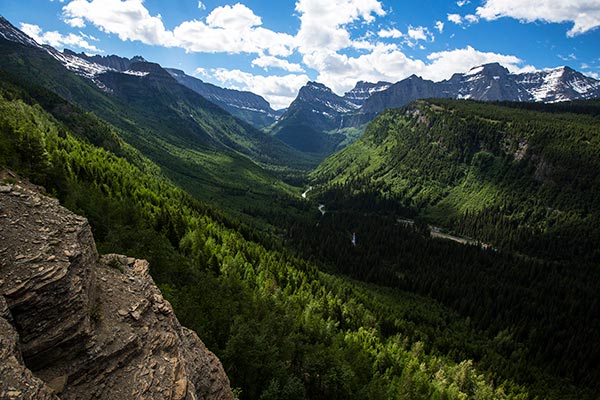Last updated: September 15, 2023
Lesson Plan
Model Glaciers

- Grade Level:
- Middle School: Sixth Grade through Eighth Grade
- Subject:
- Science
- Lesson Duration:
- 60 Minutes
Essential Question
How do glaciers carve rocks and valleys?
Objective
Students will be able to:
• Form glacial features in a sand box model river valley.
• Identify glacial features on the landscape - terminal and lateral moraines, the headwall, cirques, tributary glaciers, and hanging valleys.
Background
Using river trough from The Work of Water lesson plan, students place/move frozen ice blocks with gravel/rocks in them through the sand to form glacially carved valleys, cirques, tarn lakes, etc.
Freeze gravel and small rocks into ice blocks so they will have a rough base when they start to melt. Then thaw them enough day of class to get them out of the containers. Keep the sand, gravel, and rocks in the sandbox damp enough to mold into mountains.
This lesson is one part of Work House: A Glacier National Park Science and Indian Education Program. It can be completed as a stand alone lesson or as part of the greater Work House course.
The full Work House Program is available on Glacier National Park's website.
Background information as well as the full lesson plan can be found as a PDF here.
Preparation
- This lesson plan will require time overnight to freeze “glacier” containers. One class period to form glacial features in sand. Additional time to have ice blocks melt to see tarn lakes and till.
- Small sandbox or trough from the Work of Water Lesson Plan
- Sand, gravel and assorted small rocks
- Variety of sizes of elongated plastic containers for freezing water in.
Procedure
- Have the students form mountains and river valleys in the river sand trough.
- Take out the prepared ice blocks that have stones frozen into them. Use a large ice block to represent a large mountain glacier and several smaller blocks to represent smaller tributary glaciers.
- Place the large block at the head of the valley the students have created in the sand and slowly bulldoze a path down the river valley. Point out the gouging and plucking along the way. When you reach the terminal point of the valley, point out the terminal moraine. Be sure that you are gouging nearly to the bottom of the sandbox or trough. Point out the lateral moraines along the side of the glacier’s path.
- Give some of the students small glaciers and invite them to work a few tributary glaciers. Ask if they can produce hanging valleys, cirques, etc. . When they have finished have them leave their remnant glaciers against the headwalls.
Possible Extenstions
- As a special treat and review, get several half gallon blocks of Neapolitan ice cream, marshmallow cream topping, ground nuts to represent rocks, and whatever else you might find tasty and relevant. Then get down to business with an ice cream scoop. While reviewing glacial terminology and carving formations with the scoop, fill cups for the students who can correctly identify the latest formation.
- Ranger-Led Field Trips and Service Learning Projects in Glacier National Park. Earth Science and Forest Processes field trips about park geology.
- Self-Guided Field Trips as well as Guided Tours - various concession operated - in Glacier National Park.
- Glacier Institute - geology and other education programs.
- Guided Tours in Glacier National Park- various concession operated.
Vocabulary
Till, tributary, U-shaped valley, V-shaped valley, valley glacier.
Assessment Materials
Some time later have the students look at the debris left in the cirque as the ice block melts. Ultimately there will only remain a little pile of “till” and a small “tarn” lake if the clay layer in your trough keeps the water from all draining out.
Additional Resources
- Climate Change Resource Guide- includes Facing the Future Lessons.
- Glacier NP Teacher Cultural Resource Guide - Fact Sheets, Digital Images, Lessons.
- USGS Repeat Photography Project and Repeat Photo Education Trunk.
- Ice Patch Archaeology Resource Brief
- Glacier National Park Ice Patch Project Interactive Website with Kids Page - Confederated Salish and Kootenai Tribes of the Flathead Reservation, the Blackfeet Nation, the Univ. of Wyoming, Univ. of Colorado Boulder, Univ. of Arizona, Glacier National Park’s cultural resources program and the Rocky Mountains Cooperative Ecosystem Studies Unit (CESU).
- Flathead Community of Resource Educators Website - contains a resource link to the Flathead Watershed Sourcebook - which contains cultural and natural history of the Flathead watershed.
- Glacier National Park Conservancy Bookstores - books specific to Glacier.
